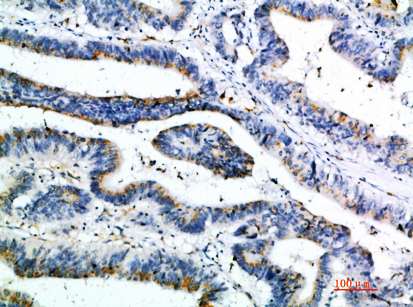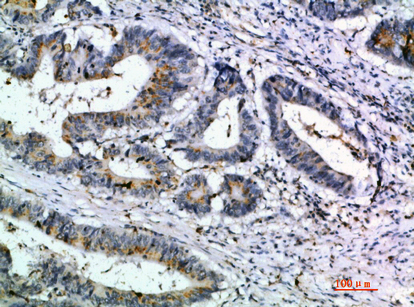6CKine Polyclonal Antibody
- Catalog No.:YT5973
- Applications:IHC;IF;ELISA
- Reactivity:Human
- Target:
- 6CKine
- Fields:
- >>Cytokine-cytokine receptor interaction;>>Viral protein interaction with cytokine and cytokine receptor;>>Chemokine signaling pathway;>>NF-kappa B signaling pathway
- Gene Name:
- CCL21 SCYA21 UNQ784/PRO1600
- Protein Name:
- C-C motif chemokine 21 (6Ckine) (Beta-chemokine exodus-2) (Secondary lymphoid-tissue chemokine) (SLC) (Small-inducible cytokine A21)
- Human Gene Id:
- 6366
- Human Swiss Prot No:
- O00585
- Immunogen:
- The antiserum was produced against synthesized peptide derived from the Internal region of human CCL21. AA range:71-120
- Specificity:
- The antibody detects endogenous 6CKine
- Formulation:
- Liquid in PBS containing 50% glycerol, 0.5% BSA and 0.02% sodium azide.
- Source:
- Polyclonal, Rabbit,IgG
- Dilution:
- IHC 1:50-200, ELISA 1:10000-20000. IF 1:50-200
- Purification:
- The antibody was affinity-purified from rabbit antiserum by affinity-chromatography using epitope-specific immunogen.
- Concentration:
- 1 mg/ml
- Storage Stability:
- -15°C to -25°C/1 year(Do not lower than -25°C)
- Other Name:
- C-C motif chemokine 21 (6Ckine;Beta-chemokine exodus-2;Secondary lymphoid-tissue chemokine;SLC;Small-inducible cytokine A21)
- Background:
- This antimicrobial gene is one of several CC cytokine genes clustered on the p-arm of chromosome 9. Cytokines are a family of secreted proteins involved in immunoregulatory and inflammatory processes. The CC cytokines are proteins characterized by two adjacent cysteines. Similar to other chemokines the protein encoded by this gene inhibits hemopoiesis and stimulates chemotaxis. This protein is chemotactic in vitro for thymocytes and activated T cells, but not for B cells, macrophages, or neutrophils. The cytokine encoded by this gene may also play a role in mediating homing of lymphocytes to secondary lymphoid organs. It is a high affinity functional ligand for chemokine receptor 7 that is expressed on T and B lymphocytes and a known receptor for another member of the cytokine family (small inducible cytokine A19). [provided by RefSeq, Sep 2014],
- Function:
- function:Inhibits hemopoiesis and stimulates chemotaxis. Chemotactic in vitro for thymocytes and activated T-cells, but not for B-cells, macrophages, or neutrophils. Shows preferential activity towards naive T-cells. May play a role in mediating homing of lymphocytes to secondary lymphoid organs.,online information:CCL21 entry,similarity:Belongs to the intercrine beta (chemokine CC) family.,subunit:Binds to CCR7.,tissue specificity:Highly expressed in high endothelial venules of lymph nodes, spleen and appendix. Intermediate levels found in small intestine, thyroid gland and trachea. Low level expression in thymus, bone marrow, liver, and pancreas. Also found in tonsil, fetal heart and fetal spleen.,
- Subcellular Location:
- Secreted.
- Expression:
- Highly expressed in high endothelial venules of lymph nodes, spleen and appendix. Intermediate levels found in small intestine, thyroid gland and trachea. Low level expression in thymus, bone marrow, liver, and pancreas. Also found in tonsil, fetal heart and fetal spleen.
- June 19-2018
- WESTERN IMMUNOBLOTTING PROTOCOL
- June 19-2018
- IMMUNOHISTOCHEMISTRY-PARAFFIN PROTOCOL
- June 19-2018
- IMMUNOFLUORESCENCE PROTOCOL
- September 08-2020
- FLOW-CYTOMEYRT-PROTOCOL
- May 20-2022
- Cell-Based ELISA│解您多样本WB检测之困扰
- July 13-2018
- CELL-BASED-ELISA-PROTOCOL-FOR-ACETYL-PROTEIN
- July 13-2018
- CELL-BASED-ELISA-PROTOCOL-FOR-PHOSPHO-PROTEIN
- July 13-2018
- Antibody-FAQs
- Products Images

- Immunohistochemical analysis of paraffin-embedded human-lymph, antibody was diluted at 1:200

- Immunohistochemical analysis of paraffin-embedded human-colon-cancer, antibody was diluted at 1:200

- Immunohistochemical analysis of paraffin-embedded human-colon-cancer, antibody was diluted at 1:200



